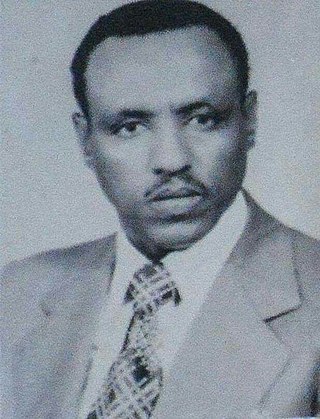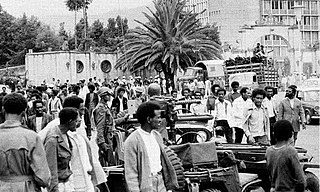Kelbessa Negewo (born 1950) is an Ethiopian man who served as an official of the Marxist Derg regime while it was in power. He oversaw the torture and murder of political opponents during the Red Terror; Kelbessa denies a role in the torture that occurred. After the fall of the Derg regime, Kelbessa moved to the United States and later gained US citizenship. In Ethiopia, he was tried and convicted in absentia, and sentenced to life imprisonment. He was later deported to Ethiopia, where he is currently serving his sentence.
Kelbessa was born in western Ethiopia in 1950, where his family raised goats. Kelbessa claims he was awarded a scholarship to study in the United States, but a government official in Emperor Haile Selassie's regime had his own nephew sent instead in Kelbessa's place. [ citation needed ]
Kelbessa later married and had three children, later divorcing. [1] When the emperor was overthrown and the Derg seized power, Kelbessa became part of a neighborhood council which was tasked with seeing to revolutionary changes in the country. He eventually progressed to the status of chairman of Higher Zone 9, one of Addis Ababa's 25 zones, where he oversaw multiple councils and was involved in recruiting members of armed "revolutionary defense squads". [1] According to author Andrew Rice, writing in The New York Times Magazine , "A series of memos... reveal that he was tireless in begging his higher-ups for more guns, more ammunition and more press coverage." [1]
According to Hirut Abebe-Jiri, an activist involved in preserving and documenting atrocities while Mengistu Haile Mariam ruled the country, and other women, Kelbessa directly oversaw their torture, and demanded to know whether they were members of the Ethiopian People's Revolutionary Party, then fighting the government in the Ethiopian Civil War. [1]
Kelbessa moved to the United States in 1987, arriving in New York City on August 3. He moved to Atlanta, Georgia, progressing from dishwasher to bellhop at the Colony Square Hotel. He was recognized in an elevator at the hotel by an Ethiopian woman, who claims he oversaw her torture while in Ethiopia. She contacted two other women who also identified themselves as his victims, and together they filed a lawsuit under the Alien Tort Claims Act, alleging a violation of their human rights. A judge awarded them US$ 1.5 million in damages, but Kelbessa filed bankruptcy. Shortly after the trial, the Ethiopian special prosecutor tasked with investigating and prosecuting crimes committed during Mengistu's rule asked for Kelbessa's extradition to Ethiopia, which was not granted. [1]
He was fired from his job at the hotel, earned a degree in accounting from DeVry University, and remarried, having a son who died in infancy and later a daughter. He became a US citizen on July 28, 1995, after which two of the women who had sued him returned to Atlanta and were taped in a CNN interview. He was tried and convicted in absentia in Ethiopia on murder charges, and sentenced to life imprisonment. [1]
In 2004 the National Intelligence Reform Act was made into law in the US. It included Senator Patrick Leahy's Anti-Atrocity Alien Deportation Act, which made torture and extrajudicial killings in other countries reason for a person's deportation from the US to that country. [2] Kelbessa was brought to trial in the US again, and voluntarily gave up his American citizenship. [1] A judge ordered him deported, and he was sent back to Ethiopia to serve his life sentence. [3]

Mengistu Haile Mariam is an Ethiopian former politician and former army officer who was the head of state of Ethiopia from 1977 to 1991 and General Secretary of the Workers' Party of Ethiopia from 1984 to 1991. He was the chairman of the Derg, the socialist military junta that governed Ethiopia, from 1977 to 1987, and the president of the People's Democratic Republic of Ethiopia (PDRE) from 1987 to 1991.

Tesfaye Gebre Kidan Geletu was an Ethiopian general who was the acting president of Ethiopia for one week in late May 1991.
Berhanu Beyeh is a former Ethiopian army officer and politician. He was Foreign Minister during the People's Democratic Republic of Ethiopia (1986–1989). Prior to that, he was chairman of the Derg's committee for legal affairs. Beyeh was a refugee resident of the Italian Embassy from May 1991 until December 2020, when he left the Embassy.

Brigadier General Tafari Benti was an Ethiopian military officer and politician who served as head of state of Ethiopia from 1974 to 1977 in his role as second chairman of the Derg, the ruling military junta. His official title was Chairman of the Provisional Military Administrative Council.

The Derg, officially the Provisional Military Administrative Council (PMAC), was the Marxist-Leninist military dictatorship that ruled Ethiopia, then including present-day Eritrea, from 1974 to 1987, when the military leadership or junta formally "civilianized" the administration but stayed in power until 1991.

The People's Democratic Republic of Ethiopia was a socialist state that existed in Ethiopia and present-day Eritrea from 1987 to 1991.

The All-Ethiopia Socialist Movement is a political party in Ethiopia. A Marxist-Leninist organization, MEISON played an active role in Ethiopian politics during the 1970s. Both it and the Ethiopian People's Revolutionary Party (EPRP) were enthusiastic supporters of the revolution that toppled Emperor Haile Selassie. However, as Mengistu Haile Mariam rose to power as leader of the ruling Derg government, conflict began to develop between the two groups. MEISON initially aligned itself with the Derg, but fell out with Mengistu as the Red Terror progressed and was repressed from mid-1977 onwards.

The Ethiopian Civil War was a civil war in Ethiopia and present-day Eritrea, fought between the Ethiopian military junta known as the Derg and Ethiopian-Eritrean anti-government rebels from 12 September 1974 to 28 May 1991.

The Red Terror, also known as the Ethiopian Red Terror, was a violent political repression campaign of the Derg against other competing Marxist-Leninist groups in Ethiopia and present-day Eritrea from 1976 to 1978. The Qey Shibir was an attempt to consolidate Derg rule during the political instability after their overthrow of Emperor Haile Selassie in 1974 and the subsequent Ethiopian Civil War. The Qey Shibir was based on the Red Terror of the Russian Civil War, and most visibly took place after Mengistu Haile Mariam became chairman of the Derg on 3 February 1977. It is estimated that 10,000 to 980,000 people were killed over the course of the Qey Shibir.
Fikre Selassie Wogderess was an Ethiopian politician who served as the Prime Minister of Ethiopia from 10 September 1987 to 8 November 1989.

Ethiopia and Russia established diplomatic relations on April 21, 1943. Russia currently has an embassy in Addis Ababa, and Ethiopia has an embassy in Moscow. The Ethiopian ambassador to Russia is also accredited to Armenia, Azerbaijan, Belarus, Georgia, Kazakhstan, Kyrgyzstan, Moldova, Tajikistan, Turkmenistan, Ukraine, and Uzbekistan.

Haile Fida was a French Ethiopian politician and the leader of the All-Ethiopia Socialist Movement. His most significant accomplishment was drafting the Program for the National Democratic Revolution on behalf of the Derg.
Captain Alemayehu Haile was a member of the Derg, the military junta that ruled Ethiopia from 1974 to 1987.
Captain Mogus Wolde Mikael was an Eritrean military officer who was a member of the Derg, the military junta that ruled Ethiopia.
Abyotawit Seded was a communist organization in Ethiopia, formed in 1976 by a group of officers of the Derg military junta who had attended political trainings in the Soviet Union from 1975 and onwards.
Alem Bekagn, or 'Kerchele Prison', was a central prison in Ethiopia until 2004. Located in Addis Ababa, the prison possibly existed as early as 1923, under the reign of Empress Zewditu, but became notorious after Second Italo-Ethiopian War as the site where Ethiopian intellectuals were detained and killed by Italian Fascists in the Yekatit 12 massacre. After the restoration of Emperor Haile Selassie, the prison remained in use to house Eritrean nationalists and those involved in the Woyane rebellion. Under the Communist Derg regime that followed, the prison was the site of another mass killing, the Massacre of the Sixty, and of the torture and execution of rival groups in the Red Terror. The prison remained a site of human rights abuses until the Ethiopian People’s Revolutionary Democratic Front entered Addis Ababa on 28 May 1991, after which it became a normal prison. The prison was closed in 2004 and demolished in 2007 to allow the construction of the headquarters of the African Union.

The fall of the Derg, also known as Downfall of the Derg, was a military campaign that resulted the defeat of the ruling military junta Derg by the rebel coalition Ethiopian People's Revolutionary Democratic Front (EPRDF) on 28 May 1991 in Addis Ababa, ending the Ethiopian Civil War. The Derg took power after deposing Emperor Haile Selassie and the Solomonic dynasty, an imperial dynasty of Ethiopia that began in 1270. The Derg suffered insurgency with different factions, and separatist rebels groups since early their rule, beginning with the Ethiopian Civil War. The 1983–1985 famine, the Red Terror, and resettlement and villagization infamed the Derg with majority of Ethiopians tended to support insurgent groups like the Tigray People's Liberation Front (TPLF) and Eritrean People's Liberation Front (EPLF).

On 12 December 2006, the Federal Supreme Court found guilty 77 top Derg officials accused by the government of the Ethiopian People's Revolutionary Democratic Front (EPRDF) over the Red Terror (1976–1978). The head of the Derg, Mengistu Haile Mariam, who fled to Zimbabwe, and other 22 Derg members were sentenced in absentia to life imprisonment on 11 January 2007.
This list details about chronological aspect of the Derg, the military junta that ruled Ethiopia from 1974 to 1987 by decade.

On 17 February 1992, the Ethiopian Radio announced the discovery of burial of the Ethiopian Emperor Haile Selassie beneath his office in National Palace by workmen. The discovery happened nearly one year after the former military government Derg collapse in 1991, and under the interim government led by the Ethiopian People's Revolutionary Democratic Front (EPRDF).